Francesco Guardi - painter
Artist evoked image of republic’s final years
One of the last great artists of the Venetian school, Francesco Lazzaro Guardi, was born on this day in 1712 in Venice. Guardi’s wonderful scenes of crowds, festivals, regattas and concerts in Venice have kept the heyday of the republic alive for future generations to enjoy in art galleries all over the world. The artist was born into a family of nobility from Trentino, who lived in a house in the Cannaregio district of Venice. Guardi’s father and brothers were also painters and his sister, Maria Cecilia, married the great Venetian artist, Giovanni Battista Tiepolo. Guardi’s first known works were painted in the 1730s in Vigo Anuania in Trentino, where he was working alongside his older brother, Gian Antonio. The first work to be signed by Guardi is the picture Saint Adoring the Eucharist, which was painted in about 1739. Guardi seemed equally comfortable painting landscapes or figures, but his early views of Venice show the influence of Canaletto on his style. In 1757 Guardi married Maria Mattea Pagani, the daughter of another painter, Matteo Pagani. One of his most important works was The Doge’s Feasts, a series of 12 canvases commissioned to celebrate the ceremonies held in 1763 for the election of Doge Alvise IV Mocenigo. Read more…
___________________________________
Andrea De Cesaris - racing driver
Career defined by unwanted record
The racing driver Andrea De Cesaris, who competed in 15 consecutive Formula One seasons between 1980 and 1994, died on this day in 2014 as a result of injuries sustained in a motorcycle accident. De Cesaris lost control of his Suzuki motorcycle on Rome’s orbital motorway, the Grande Raccordo Anulare, and collided with a guard rail. The Rome-born driver, the son of a tobacco merchant, retired from competition with the unwanted record of having never won a race in 208 Formula One starts, the most by any driver without a victory to his name in the sport’s history. He needed no second invitation to hit the accelerator on the track but his daring often veered towards the wild and erratic and had a reputation for being accident prone, putting not only himself but other drivers at risk. His tendency to drive into trouble gave him a number of other records he would have preferred not to have earned: the most consecutive non-finishes, 18 between 1985 and 1986, although that includes mechanical failures, the most successive non-finishes in a single season, 12 in 1987, when he also set the record for the most non-finishes in a single, 16-race season, at 14. Read more…
_______________________________________
Alberto Sughi - painter
20th century artist who was unwitting victim of plagiarism
The artist Alberto Sughi, an acclaimed 20th century painter whose style was defined as “existential realism”, was born on this day in 1928 in Cesena in Emilia-Romagna. Sughi was regarded as one of the greatest artists of his generation but is often remembered mainly for his unwitting part in a famous case of plagiarism. It happened in 2006 when a Japanese painter, Yoshihiko Wada, was awarded the prestigious Art Encouragement Prize, the Japanese equivalent of the Turner Prize, for a series of paintings depicted urban life in Italy - one of Sughi’s specialities. A month after the award was announced in March of that year, the Japan Artists Association and Agency for Cultural Affairs received an anonymous tip-off questioning the authenticity of Wada's work, which then sparked an investigation into possible plagiarism. The anonymous accuser had noted that several pieces of Wada’s art in an exhibition before the award was decided bore striking similarities to paintings by Sughi. Two examples were Wada’s Boshi-zo (Mother and Child), which looked almost exactly like Sughi’s Virgo Laurentana, even in tiny details, and Wada’s Muso (Reverie), which appeared to be a near-identical copy of Sughi’s Piano Bar Italia. Read more…
_______________________________________
Mary of Modena – Queen of England
Catholic wife of James II greeted with suspicion
Maria Beatrice Anna Margherita Isabella d'Este, who would become known in England as Mary of Modena when she served as queen consort for almost four years in the 17th century, was born on this day in 1658. The daughter of Alfonso IV, Duke of Modena, the princess, descended from the Bourbon royal family of France and the Medici family of Italy, was born in the Ducal Palace in Modena. Her mother, Laura Martinozzi, from Fano in the Marche, hailed from a noble Roman family. Tall, elegant and highly educated – she was fluent in French as well as Italian and had a good knowledge of Latin – Maria Beatrice was sought after as a bride for James, Duke of York, heir to Charles II. She was picked as a suitable prospective bride for his Catholic master by Lord Peterborough, one of the Duke’s closest aides, who communicated with the d’Este family through French diplomatic channels. James was a widower following the death of his first wife, Anne Hyde. He was no great catch, 25 years older than Maria Beatrice, scarred by smallpox and venereal disease and afflicted with a stutter. Read more…
.jpg)







.jpg)
.png)
.jpg)

%20(1).jpg)



.jpg)

